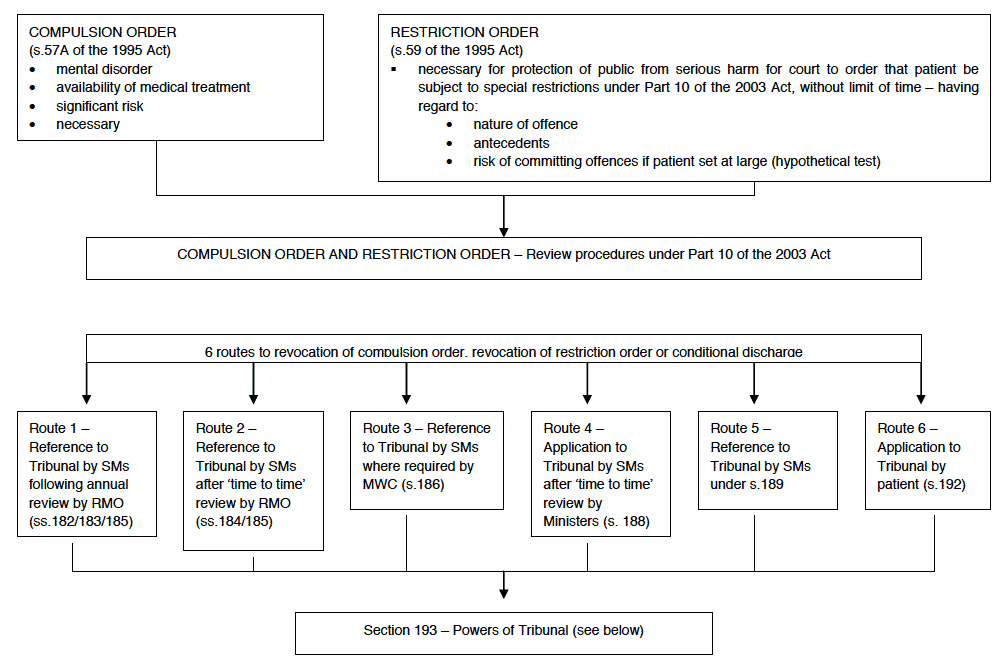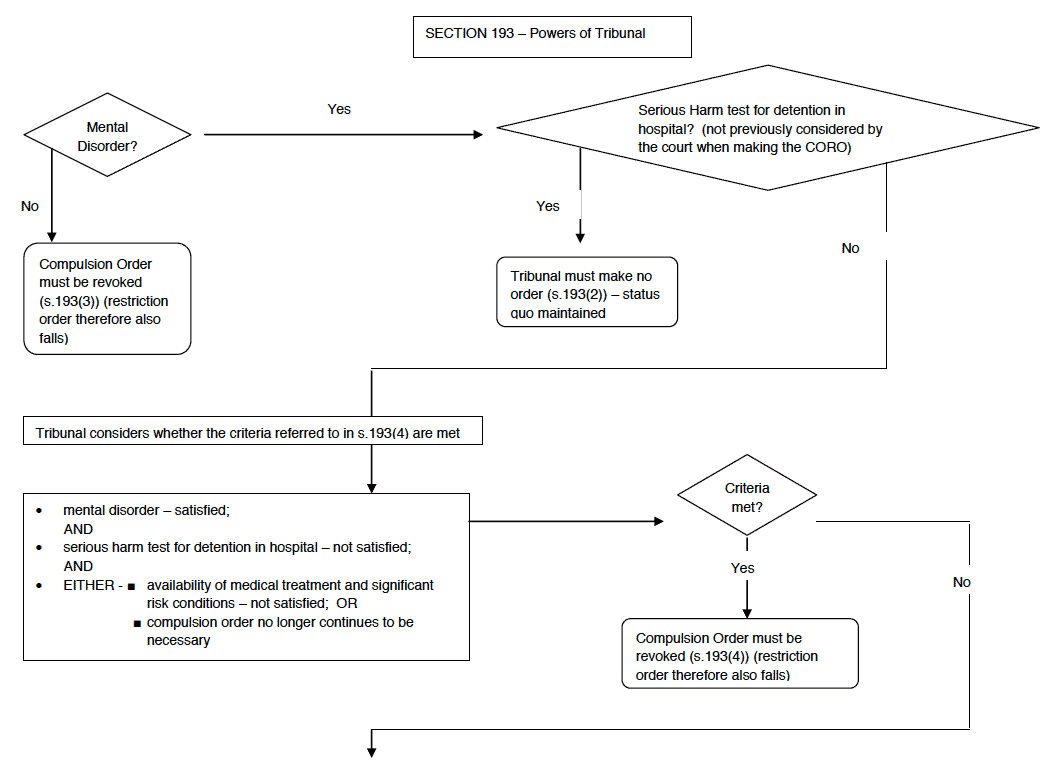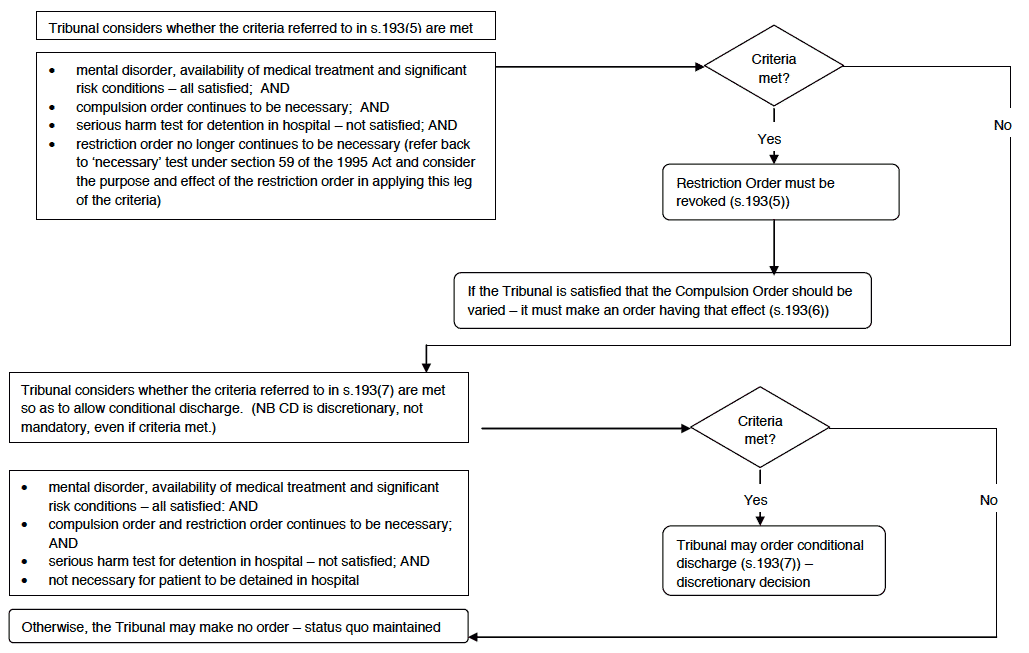Memorandum of Procedure on Restricted Patients
An essential reference document for those who are involved in the management and care of patients subject to a compulsion order with restriction order.
7 MANAGEMENT IN HOSPITAL
Admission/Three Month report
7.1 The Scottish Ministers require a report to be provided on each restricted patient admitted to hospital (whether from court or on transfer from prison or another hospital) within 3 months of admission 58. A copy of the Part 9 Care Plan should accompany this report. For restricted patients admitted to the State Hospital, an admission history is routinely provided after the patient has been in hospital for 6 weeks. This may form part of the patient's 3-month report following admission, provided that there is a brief update on the patient's current mental state.
Annual reports
7.2 The Responsible Medical Officer (" RMO") is required to prepare and submit a report on each restricted patient annually on the anniversary of the date they received their hospital disposal or were admitted to hospital under a transfer for treatment direction 59. A copy of the most recent CPA documentation (which includes the Part 9 Care Plan) should accompany this report. The report must contain the information outlined in section 183(3) or section 207(3) of the Mental Health (Care and Treatment) (Scotland) Act ("the 2003 Act"), in addition to any particulars which Scottish Ministers may require. A template is offered here.
7.3 The RMO must, in the 2 month period ending with the anniversary of the date on which the order was made, examine the patient, consult with the designated Mental Health Officer (" MHO") and, as soon as practicable thereafter, prepare and submit a report to the Scottish Ministers.
7.4 The annual report should be accompanied by form CORO1 for those patients on a compulsion order and restriction order or form HD1 for those patients subject to a hospital direction or transfer for treatment direction. In preparing reports, the RMO is expected to take into account the views of the multidisciplinary team caring for the patient including psychology, and in particular the views of the designated MHO. However, the RMO must take responsibility for all reports to the SGHD on a restricted patient, with the exception of reports prepared by the MHO or psychologists. Annual or 3 month reports not prepared by the RMO must be countersigned by the RMO to indicate agreement with the opinion given.
7.5 The importance of this reporting mechanism for the Scottish Ministers is twofold. Firstly, in terms of the Scottish Ministers' overarching interest in ensuring that the legislation is being complied with by those upon whom a statutory duty is placed under the Act. Secondly, however, the Scottish Ministers also have a more direct interest in that the report then enables them to perform their own separate statutory duties in relation to the restricted patient, in accordance with Part 10 of the 2003 Act. Accordingly, SGHD routinely writes to RMOs to remind them of their statutory duty to review a patient's CORO, HD or TTD in the 2 month period prior to the relevant anniversary date. Accordingly, within that letter, SGHD will routinely:
- remind RMOs that any failure by an RMO to carry out the mandatory annual review and/or to provide the report to Scottish Ministers, as required under the 2003 Act, is a breach of a statutory duty by that RMO; and
- highlight that any such failure by the RMO has the consequence of preventing the intended operation of the remainder of the review process, and thereby the Scottish Ministers' role in that process; and that the Scottish Ministers take very seriously their statutory responsibilities in respect of restricted patients, and particularly those who are living in the community.
State Hospital intermediate review reports
7.6 While there is no statutory requirement for such reports to be provided to the Scottish Ministers, it is considered good practice for an RMO to copy these reports, as they relate to restricted patients, to the PMO( FP) and the designated MHO.
Content of reports
7.7 Each report (admission, 3 month, annual), in addition to providing background information on the patient at this stage, must provide the RMO's opinion of the patient's current mental state and whether (by reference to the criteria set out in the 2003 Act) the patient is detainable under the mental health legislation at the time of making the report. (Psychiatrists will be familiar with these tests and they are set out in, for example, section 182(3)(b) of the 2003 Act.) A Part 9 care plan is required as part of the report at annual review. Each report must also contain the patient's CHI number.
Guidance on reporting on restricted patient's mental state and appropriate detention
CORO patients
7.8 When preparing a report on a CORO patient to the Scottish Ministers, the RMO must meet the requirements of section 182(3) of the 2003 Act. Those requirements are:
(a) to carry out a medical examination of the patient (or make an arrangement for an approved medical practitioner to carry out such an examination);
(b) to consider whether the criteria outlined in sections 182(3)(b) and s182(4) (paragraph 7.11 are met in relation to the patient; and
(c) and to consult with the Mental Health Officer.
7.9 The criteria outlined in sections 182(3)(b) and (4) which must be considered by the RMO in conducting the review and preparing the report to the Scottish Ministers are whether:
1. the patient has a mental disorder;
2. medical treatment which would be likely to -
(i) prevent the mental disorder worsening; or
(ii) alleviate any of the symptoms or effects of the disorder,
is available for the patient;
3. if the patient were not provided with such medical treatment there would be a significant risk -
(i) to the health, safety and welfare of the patient; or
(ii) to the safety of any other person;
4. as a result of the CORO patient's mental disorder, it is necessary, in order to protect any other person from serious harm, for the patient to be detained in hospital, whether or not for medical treatment (the "detention in hospital" test);
5. it continues to be necessary for the CORO patient to be subject to the compulsion order (the "necessity for a compulsion order" test); and
6. it continues to be necessary for the CORO patient to be subject to the restriction order (even if not requiring detention in hospital) (the "necessity for a restriction order test").
These factors are statutory criteria, so they must all be applied.
7.10 The RMO must therefore, in the first instance, provide their present diagnosis for the CORO patient including whether they consider that the patient suffers from a mental disorder. In the 2003 Act, mental disorder is defined as:
- mental illness;
- personality disorder; or
- learning disability
7.11 The RMO must then go on to consider whether each of the 5 other criteria are met. It is important that reasons are given in the report for the conclusion reached in respect of each of the tests.
7.12 It should be noted in relation to a restriction order that the "risk of serious harm requiring detention in hospital" test is a quite separate test from the "necessity for a restriction order" test. A recommendation for revocation of a restriction order will only be appropriate where the RMO is satisfied that both tests are not met. In other words, even if the RMO considers that the restricted patient does not meet the test of "risk of serious harm requiring detention in hospital (whether or not for medical treatment)", the RMOmust separately go on to consider whether or not otherwise, or in any case, the restriction order "continues to be necessary". In relation to that latter test of whether or not the restriction order "continues to be necessary", Scottish Ministers' view is that those applying the statutory test must have regard both to:
1. the original criteria which the court considered when imposing the restriction order, i.e. having regard to:
(i) the nature of the index offence,
(ii) the antecedents of the patient, and
(iii) the risk that the patient would commit further offences if at large;
2. whether it is necessary for the protection of the public from serious harm for the patient to be subject to the restriction order;
and
3. the nature and effect of the restriction order on the patient's present circumstances *.
( *With particular regard to the statutory overseeing role afforded to the Scottish Ministers under the 2003 Act; the decision making role of the Tribunal; the involvement of MAPPA in assessing risk; and the fact that without the restriction order, the compulsion order becomes time limited). See the necessity for restriction order test guidance attached to the RMO annual report template.
7.13 This approach was approved by the Court of Session on 11 February 2009 in the case of JK [ http://www.scotcourts.gov.uk/opinions/2009CSIH9.html]. Therefore, any recommendation for the revocation of a restriction order must address both the original criteria for imposing the restriction order and its nature and effect on the patient's current circumstances, and give reasons why these considerations no longer apply.
HD and TTD patients
7.14 When preparing a report on a HD or TTD patient to the Scottish Ministers, the RMO must meet the requirements of section 206(3) of the 2003 Act. Those requirements are similar to those in relation to a CORO patient, namely:
(a) to carry out a medical examination of the patient (or make an arrangement for an approved medical practitioner to carry out such an examination);
(b) to consider whether certain criteria are met in relation to the patient; and
(c) to consult with the Mental Health Officer. Note that for HD and TTD patients the RMO must also consult with such other persons as the RMO considers appropriate.
7.15 Again, the criteria which require to be considered in relation to a HD patient or TTD patient, which are set out at section 206(4) are similar to those in section 182(4) for CORO patients as outlined at paragraph 7.9 above.
7.16 The RMO must then go on to consider whether:
- as a result of the HD patient or TTD patient's mental disorder, it is necessary, in order to protect any other person from serious harm, for the patient to be detained in hospital, whether or not for medical treatment (the "detention in hospital" test); and
- it continues to be necessary for the HD patient or TTD patient to be subject to the direction in question (the "necessity for the direction" test).
7.17 If the patient is a TTD patient, in considering whether or not the TTD remains necessary, the RMO should also consider whether the patient should be returned to the prison establishment. The Scottish Ministers are not required to revoke the TTD and so transfer back to prison anyone who is suffering from a mental disorder, where the effect of such is that it is necessary to protect the public from serious harm that the patient remain in hospital. However, different considerations may apply when considering the environment into which the patient might be transferred.
7.18 As noted at paragraph 7.5 above, provision of these reports is a main route through which the SGHD obtains current information on a restricted patient. It is therefore vital that the RMO ensures that all relevant information on the patient is provided, and timeously. This should include any information that might provide further background detail on a patient that was not previously available or has become clearer or more detailed with time.
7.19 Of Course, the RMO may at any time provide information to SGHD on a patient and must in any case provide reports on any serious incidents which affect a patient at the time of their occurrence, which should always be copied to the designated MHO. If, in the interval between annual reports, the RMO considers that the patient's mental condition has changed in such a way that the Scottish Ministers should be informed, they should take the initiative in making any additional report or recommendation that they consider appropriate. In assessing proposals regarding restricted patients, the SGHD looks for evidence of both appropriate risk assessment and effective risk management. See Chapter 3 for details. This will enable Scottish Ministers to consider what action, if any, needs to be taken in the light of the RMO's and designated MHO's current view on the patient.
7.20 Where there are any other unusual factor, for example, if the hospital receives information about any form of application to the Mental Health Tribunal, appeal to the Courts or further charges brought against the patient, the RMO should notified the SGHD and the designated MHO at once.
Order for Lifelong Restriction
7.21 As outlined in Chapter 6, the introduction, in June 2006, of the Order for Lifelong Restriction (" OLR") equipped courts with a new provision for the sentencing and treatment of violent and sexual offenders who pose a continuing danger to the public. As a form of life sentence, an OLR can only be imposed by the High Court. But it differs from a life sentence or a long determinate sentence because of the crucial element of risk assessment which is undertaken prior to sentence being passed. Where the Fiscal believes that there may be grounds for the making of an OLR, e.g. as a result of the person's offending history, the Crown will make an application to the Court at the time of conviction for a Risk Assessment Order (" RAO"). The RAO is the mechanism by which a person is assessed for an OLR. If the application for the RAO granted, it allows up to 90 days for an accredited assessor to prepare a Risk Assessment Report.
7.22 An OLR or a RAO can, in certain circumstances sit alongside, a mental health order. These are:
- an Interim Compulsion Order patient who is subject to a RAO;
- an OLR and a Hospital Direction ( HD);
- an OLR and a transfer for treatment direction ( TTD); or
- a CORO patient who is also subject to a RAO.
In such cases, the RMO must be aware of the interaction between the OLR/ RAO and mental health orders and any additional responsibilities placed on him, particularly in relation to updating of risk management plans and the role of the Risk Management Authority (" RMA").
Risk Management Plans and the Risk Management Authority (" RMA")
7.23 Within 9 months of an Order for Lifelong Restriction (" OLR") being granted, a risk management plan requires to be prepared by the "lead authority" and approved by the RMA. In normal practice the RMA would expect the risk management plan to be submitted to them no later than 7 months after the OLR takes effect to allow time for them to review the plan and suggest any alterations prior to the statutory 9 month deadline. Once a risk management plan is in place it can be amended as many times as necessary to take account of changes in the person's circumstances. However, each amendment must be approved by the RMA. An annual progress report must also be submitted to the RMA on the anniversary of the making of the OLR.
7.24 In the case of the first three scenarios mentioned in Paragraph 7.22 above, the Health Board would be classed as the "lead authority" and therefore the preparation of the risk management plan may come under the responsibility of the RMO. In the fourth scenario the "lead authority" will be the prison in which the person was first detained, however it is likely that the RMO will be asked to input into the risk management plan and will need to be involved in subsequent updates and annual progress reports.
7.25 For further information and advice about OLRs and RAOs contact the RMA.
Compulsion Order and Restriction Order



There is a problem
Thanks for your feedback